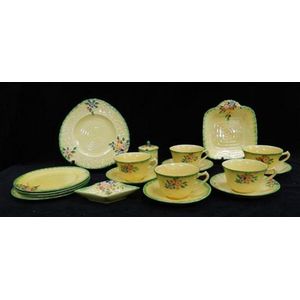Crown Devon was a British pottery manufacturer that was founded in the late 19th century in the town of Devonport, England. The company, originally known as "Fieldings," was established in 1878, and it produced a wide range of ceramic items, including tableware, vases, and figurines. In the early 20th century, the company changed its name to "Crown Devon" to reflect its growing reputation for producing high-quality, hand-painted porcelain.
Throughout the early 20th century, Crown Devon established a reputation for producing high-quality, hand-painted porcelain with intricate designs. The company's porcelain was known for its delicate and
more...
detailed patterns, as well as its bright and vibrant colors. It also produced a wide variety of items, including plates, cups, saucers, figurines, and vases. Many of these pieces were decorated with gold and other precious metals, which added to their luxury and elegance.
Crown Devon was also known for its Art Deco-style pottery, which was produced during the 1920s and 1930s. This style of pottery was characterized by its clean, geometric lines and bold, colorful designs, and it was very popular during this time period.
In the mid 20th century, Crown Devon faced financial difficulties and the business closed in 1982.
less...
A cruet also known as a caster, is a small container to hold condiments such as oil, vinegar, mustard, pepper. Its shape and adornments will depend on the specific condiment for which it is designed. For example a cruet for liquids may have a jug-like shape, while a cruet for a spice may be cylindrical with a lid and perhaps a small spoon for serving.
Cruets were made in silver, silver plate, ceramic and glass, and sometimes a combination of two materials, usually as a glass body with a silver or silver plated top.
The earliest cruets, from the
more...
beginning of the 18th century were known as "Warwick cruets" after a cruet set made by Anthony Nelme in 1715 for the Duke of Warwick, and include three elaborately decorated and shaped matching silver casters, usually with one unpierced, which held powdered mustard, and the other two for oil and vinegar, combined in a stand with a handle enabling it to be passed between dinner guests.
In the Victorian era with more elaborate dining settings, the number of condiments used during a meal increased, as did the number of containers in the cruet set, and some cruet sets contained up to six or eight containers, either arranged tw-by-two, or in a circular container. Glass bottles replaced the silver containers of the earlier era and the holders became simpler, sometimes being a metal frame attached to the base.
Completeness and originality is important when purchasing a cruet set, and missing containers, replaced containers and missing or chipped stoppers will depreciate the value of a cruet set.
Another type of cruet set is an egg cruet, typically consisting of four to eight egg cups in a stand, often with a spoon for each egg cup. These were mainly made in silver or silver plate, and occasionally ceramic. The egg cups may fit in rings, or over a stud on the base of the stand. Sometimes the interiors of the egg cups are gilded to prevent corrosion. The stands are either solid, or a framework with a handle.
less...




 Loading more...
Loading more...